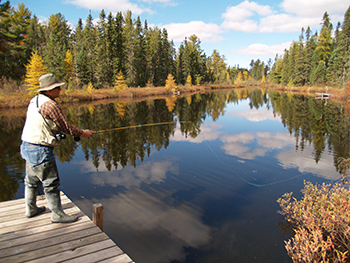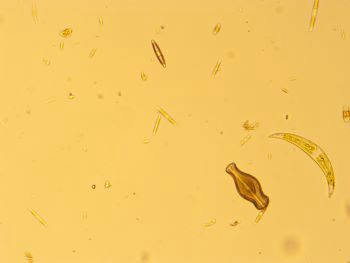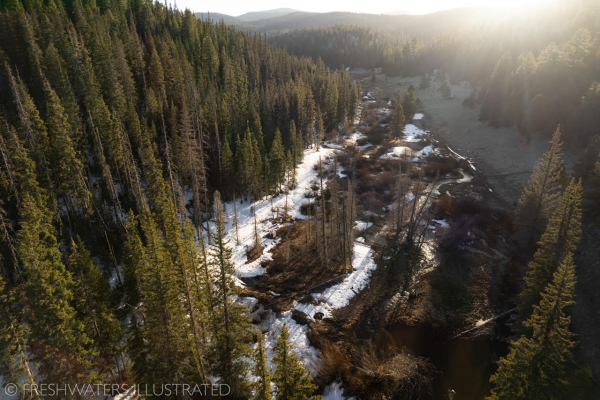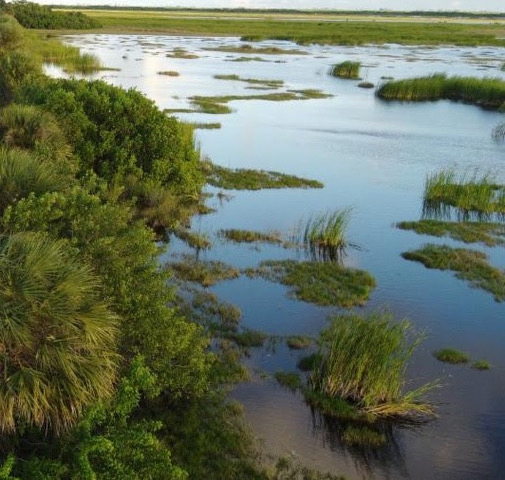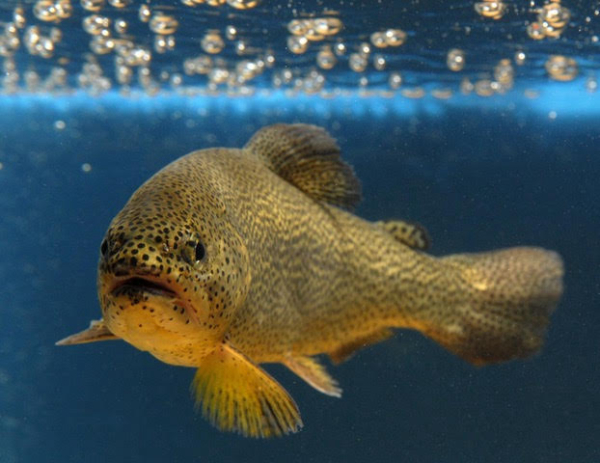Anglers help protect Michigan’s waters from invasive mudsnails
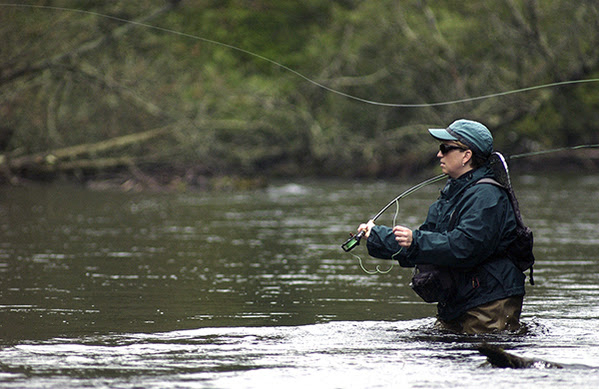
By JOANNE FOREMAN
Michigan Department of Natural Resources

Thousands of anglers across the state are poised to dip their waders into cold-water Michigan lakes, rivers and streams beginning Saturday, looking to tempt a prize brookie, a colorful rainbow or sleek German brown trout.
As they move from one spot to the next, anglers can unknowingly help spread a devastating invasive species, the New Zealand mudsnail.
“If you are going to fish different streams, be sure to clean your waders and boots,” said Jeff Gerwitz, a member of the Vanguard Chapter of Michigan Trout Unlimited, supporting Oakland County’s Paint Creek. “Some people don’t think it’s a big deal or concern, and they don’t take the time to clean and inspect between sites, but now we’re finding these mudsnails in more and more places.”
New Zealand mudsnails were first discovered in the U.S. in Idaho’s Snake River in 1987. Since then, infestations have spread throughout the western states and into areas of the Great Lakes.
Their discovery in the Pere Marquette River in August 2015 marked the first detection in a Michigan inland waterway. Within the next year, mudsnail populations were confirmed in the Boardman and Au Sable rivers.
 |
| By 2017, they were found in the Manistee River and the Pine River near the Tippy Reservoir.
Greg Potter of Marshall has been involved with Trout Unlimited’s Kalamazoo Valley chapter for over 25 years and until recently served as the organization’s state education director. He is worried about the impacts of New Zealand mudsnails in Michigan. “Any time we change the environment, it’s going to do something,” he said. “Mudsnails affect the lower end of the food chain for fish, edging out insects and larvae that fish eat. We’re going to see effects from that.” These tiny, brown to black snails can reproduce asexually, by cloning. A single snail can produce over 200 offspring in a year, leading to dense populations in a short time. “When I first heard of the New Zealand mudsnails on the Boardman, I visited a friend who lives on the river,” said Frank Simkins, a long-time angler and member of the Adams Chapter of Trout Unlimited, serving the Traverse City area. “I waded out and the snails were really thick, on every rock and stick. That part of the river was changed, with silt and snails rising like clouds when you walked through it.” |
 |
| With funding from the Michigan Invasive Species Grant Program, Dr. Scott Tiegs and graduate researcher Jeremy Geist at Oakland University set out to track mudsnail populations in Michigan.
Over the past two summers, Geist and a team of undergraduate researchers have documented a dramatic increase in density of New Zealand mudsnail populations in the Au Sable River. Engaging citizen scientists Tiegs and Geist were eager to expand their search to other river systems, but standard survey methods were difficult and time-consuming. In the lab, the project team designed a method for citizen scientists to collect environmental DNA samples, which can provide an early indication of the presence of New Zealand mudsnails in a waterway before the snails themselves might be seen. The method involves collecting stream water in a large syringe fitted with a special filter that collects DNA shed from organisms. Citizen scientists complete a training session then follow the protocols to fill the syringe five times, until one liter of water is passed through the filter. The whole sampling kit is then returned to Oakland University to test for mudsnail eDNA. Now, through a partnership between Oakland University, Grand Valley State University, Michigan Trout Unlimited and Anglers of the Au Sable, citizen scientists like Gerwitz, Simkins and Potter are putting on their waders to test rivers and streams across the state. “The volunteer base of Trout Unlimited puts a lot of effort into assuring our rivers and streams in Michigan are healthy and self-sustained,” said Geist. “Reaching out to these anglers who are committed to the resource was a logical step.” Many of the volunteers were already involved in an Adopt-a-Stream program, which monitors macroinvertebrates – insect larvae and snails that make up most fish diets. |
 |
| Macroinvertebrates have proven to be good indicators of water quality and stream health. Testing for mudsnail eDNA was a simple addition to the volunteer sampling efforts.
To date, no detections by eDNA sampling efforts have been verified on rivers or streams beyond the Pere Marquette, Boardman, Au Sable and Manistee rivers. Stopping the spread Once introduced into a river system, New Zealand mudsnails tend to travel downstream with the current and occasionally make their way upstream, possibly by being eaten and then deposited by fish. The snail’s hard shell and closeable hatch, called an operculum, help it resist digestion, providing no nutritional value to fish. On their own, the snails do not move far. It takes human help to introduce them to a new water body. New Zealand mudsnails likely were introduced to Michigan rivers by anglers who had fished in infested waters out west, then traveled to the state without knowing that a small snail or two had hitchhiked a ride on their gear. The mudsnail’s ability to seal its shell means that it can survive out of water for several weeks. Now that the mudsnails are in five rivers in Michigan, there is the potential for them to spread to many other locations. The only way to prevent their spread, and the damage they cause to the environment and fish populations, is for anglers and recreationalists to take precautions. The Oakland University team compared products and methods to determine the best way for fly fishers to decontaminate their waders. Their results indicate that a spray treatment of Formula 409 was effective in killing New Zealand mudsnails. Clean your gear Based on this study, the team developed a simple protocol that all anglers should use before travelling to a new water body. Note that this should be done away from the water’s edge:
|
 A short video shows just how easy it is to clean waders using this method. A short video shows just how easy it is to clean waders using this method.
A kit including a scrub brush, a bottle of Formula 409 and a gallon of water is all that is needed to decontaminate gear. “The process is quick and can be done at home if you aren’t visiting another stream,” said Gerwitz, “but it’s very important to do it in the field if you are heading to another location.” Spread the word Trout Unlimited’s Michigan Trout magazine has published several articles encouraging anglers to adopt decontamination practices to avoid spreading New Zealand mudsnails. Tiegs and Geist are visiting Trout Unlimited chapter meetings to share information about the invasive snail and demonstrate the wader-cleaning process. The Michigan Department of Natural Resources’ Law Enforcement Division is reaching out to anglers, handing out mudsnail information cards at boat landings and talking with anglers to gauge their level of understanding about mudsnails and decontamination practices. The consensus is that much more needs to be done to raise awareness and encourage participation. “People’s habits just aren’t changing as fast as they should be,” said Simkins. “Anglers and boaters are out there because they are nature lovers, but they often just don’t want to take the time to clean their gear.” During the upcoming trout season please be sure to take time to inspect and clean your gear – make it a new habit. When the opportunity arises, spend a moment telling your friends and fellow anglers how they can help protect the sport they love by preventing the spread of New Zealand mudsnails. For more information about invasive species and preventing their spread, visit Michigan.gov/Invasives. |
Check out previous Showcasing the DNR stories in our archive at Michigan.gov/DNRStories. To subscribe to upcoming Showcasing articles, sign up for free email delivery at Michigan.gov/DNR.

